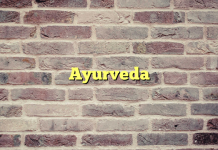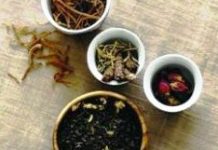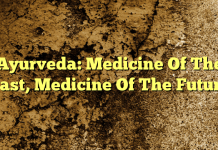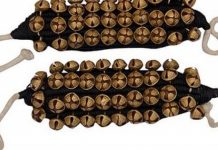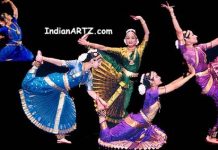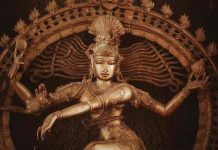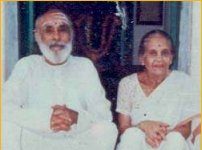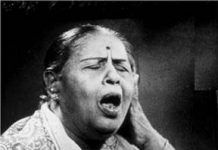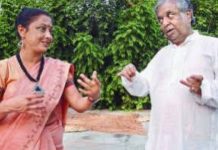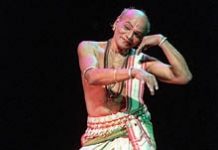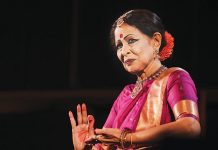History of Bharathanatyam
The term “Bharathanatyam” was introduced by Rukminidevi Arundale, and is thought to derive from:
BHAva(expression) + RAga (music) + TAla(rhythm) + NATYAM(dramatic art)Bharathanatyam is the most widely practised of classical Indian dances in South India, and has its origin in Tamil Nadu. It is the most ancient of all the classical dance forms in India, which are based on Natya Shastra, the Bible of the classical Indian dance. Gods and Godesses pleaded with Lord Brahma for another Veda to be created that would be simple for the common man to understand, which is particularly important in Kali Yuga. Granting their wish, Lord Brahma created the Panchamaveda, theFifth Veda or NatyaVeda, an essence of the main four Vedas. Brahma took pathya (words) form the Rigveda, abhinaya (communicative elements of the body movements, cf. mime) from the Yajurveda, geet (music and chant) from Samaveda, and rasa (vital sentiment and emotional element) from Atharvaveda to form the fifth Veda, NatyaVeda. After creating this Veda, Lord Brahma handed it to sage Bharata and asked him to propagate it on earth. Obeying the fiat of Lord Brahma, sage Bharata wrote Natyashastra down. It became the most authoritative text on the artistic technique of classical Indian dances, especially Bharathanatyam and Odissi. It is also possible that the term “Bharathanatyam” derives its name from sage Bharata.Another version of the origin of Bharathanatyam is that Goddess Parvathi taught this dance art to Usha, daughter of demon Banasura. Usha handed it down to the Gopikas of the city of Dwaraka, Lord Krishna’s birth place. In reality, one can imagine that the Gods and the Goddesses, being dancers themselves, have been passing the art of the heavenly dance through many other human channels, whose aptitude, understanding, and personal idiosyncrasies naturally varied from person to person, and created a number of styles ranging from Odissi to Bharathanatyam.Lord Shiva is himself the Supreme Dancer, and the whole Universe is His Divine Dance. Goddess Parvathi is dances with Him. The Dance performd by Lord Shiva is known as Tandava, virile aspect. The tandava performed with bliss is called Ananda Tandava. The tandava of the violent and destructive aspect is called Rudra Tandava. There are 7 types of Tandava in Bharathanatyam: Ananda Tandava, Tripura Tandava, Sandhya Tandava, Samara Tandava, Kaali tandava, Uma Tandava and Gauri Tandava. There are some Bharathanatyam experts who distinguish 16 types of Tandava. Tandava produces vigourous, brisk movements. When the dance is performed by Goddess Parvathi, it is known as Lasya, where the movements are soft, gentle, graceful and sometimes seen as erotic. Some Bharathanatyam scholars consider Lasya as the feminine version of Tandava. Lasya is of 2 kinds: Jarita Lasya and Yauvaka Lasya. Bharathanatyam has been undergoing a lot of change over the centuries. It used to be and is still mostly performed by women dancers. Centuries ago the Hindu temples in South India had dancers-priestesses called devadasis who would sing, dance Dasi Attam (old Bharathanatyam), play many musical instruments. They were well-versed in Sanskrit and other languages as they had to adapt compositions to suit the audience. The devadasi tradition gradually degraded. Initially, devadasis lead a very strict and celibate life and were not allowed to have a family. As the dance entered the royal courts, the dancers were called Rajanartakis, who performed in the royal courts and gradually became royal concubines. The British colonial rule has completely corrupted the devadasi tradition. In the first half of the 19th century Bharathanatyam was revitalized and redefined by the contributions of four talented brothers known today as the Tanjore Quartet: Chinniah, Sivanandam, Ponniah and Vadivelu. By coordinating their diverse talents, the four managed to organize all the basic Bharathanatyam movements of pure dance into a progressive series, adavus. Each adavu is a basic unit taught in systematic order and then combined with others to produce choreographed Bharathanatyam sequences based upon the rhythmic pattern of a musical composition. The brothers composed new music specifically for Bharathanatyam, and introduced a different sequence of items which integrated various aspects of dance and music into a carefully coordinated, aesthetically sound progression. This infusion of creative energy marks the early 19th century as one of the most innovative periods in the history of Bharathanatyam. In the 20th century, the social status and image of Bharathanatyam was restored by Rukminidevi Arundale, the founder of Kalakshetra. Bharathanatyam has undergone much change but is still deeply rooted in the spiritual Hindu heritage. Contemporary Bharathanatyam dancers are both male and female artists. While most learn it as a hobby, very few make it their career and a lifestyle, as it is extremely demanding and complex in terms of dedication and daily practise.Brief overview of BharathanatyamBharathanatyam comprises three aspects, Nritta, Nritya and Natya.
- Nritta are rhythmical and repetitive elements, i.e. it is dance properNritya is a combination of Nritta and NatyaNatya is the dramatic art, and is a language of gestures, poses and mime. cf. Abhinaya
Nritta can be broadly divided into Chari, Karana, Angahara and Mandala. One-leg movement are called Chari, two-leg movements are Karana. 3 Karanas make a Khanda. 3 to 4 Khandas make a Mandala. 4 to 9 Karanas make a Angahara. 4 to 5 Angaharas also make a Mandala. 108 Karanas and 32 Angaharas are defined in Natyashatra. The 13 Nritta Hastas (see below) are used to perform nritta. The rythmic body movements along with hand gestures are called Aduvus. A number of aduvus constitute a Jati. Jati will generally end with a Muktaya or Teermana.
There are diferent types of Aduvus: Tattaduvu, Mettaduvu, Nataduvu, Kattaduvu, Kudittamettaduvu, Maiaduvu, Mandiaduvu, Jati, Nadai, Ardi. There are 12 aduvus in each type, making it 120 aduvus in total. Only about 70-80 are generally practised by an average Bharathanatyam dancer. Aduvus are often confused with the 108 Karanas carved in the Chidambaram Temple in Tanjore, Tamilnadu, India. Some adavus, such as aramandi, are very difficult to perform. The entire body is divided into Anga, Pratyanga and Upaanga.
AngaPratyangaUpaangaAnganyatra shirohastau vaksha paarshwakateetatau
Paadaviti shaduktaani greevamapyapare jaguhuPratyangaani twathaskandhau baahoo prushtam tathodaram ooroo janghe shadityahurapare manibandhakau jaanooneekoorparamiti trayamapyadhikam jaguhuDrushtibhrooputatarashcha kapolau naasikaahanuhu
Adharodashanaa jihwaa chubukam vadanam tatha
Upaangani dwadashitaanyanyaanyangaani santi cha
Paarshnee gulbautathangulyaa karayoho padayostaleHead, Hands, Chest, Waist, Bottom, Legs are the Six Angas.
Some Bharathanatyam experts distinguish also Neck.Shoulders, Arms, Stomuch, Thighs, Knees are the Six Pratyangas.
Some Bharathanatyam experts distinguish also Wrists, Elbows and Ankles . Sight, Eyebrow, Eyelids, Eyeballs, Cheeks, Nose, Gums, Lower lip, Teeth, Tongue, Chin and Face are the 12 Upaangas.
Some Bharathanatyam experts distinguish also Heels, Fingers, Feet and Palms.
Pratynaga and Upaangas should move along with the Angas. Anga Lakshana, the movements of body parts, are described below.
- Shirobhedha – Head MovementGreevabhedha – Neck MovementDrushtibhedha – Eye MovementPaadabhedha
Mandala – Standing Posture
Utplavana – Leaps
Bhramari – Circling Movement
Chari – Leg Movement
Gatibhedha – Charecteristic walks and
Hastas or Mudras – Hand Movements
Asamyuta Hasta
Samyuta Hasta
Deva Hasta
Dashavatara Hasta
Navagraha Hasta
Jaati Hasta
Bandhu Hasta
Nritta Hasta
When all Angas(main body parts) are coordinated (along with pratyanga and upaanga), the Bharathanatyam dancer is said to possess Angashudhi. Anga meaning body parts, and shudhi means perfection or purity. The Natyashastra has shlokas describing how to perform all the above movements. Abhinaya in BharathanatyamThe techniques of communicating a message are Abinaya. Here the emphasis is more on facial expressions and gestures. While gestures can be seen from any distance even in a large dance hall, the subtle facial expressions can only be seen from the front rows. Thus, unless a Bharathanatyam recital is held in a small hall, a close-up, high-resolution video is the only adequate medium of presenting the Abhinaya.
The Abinaya is comprised of
- Angikabhinaya
- Vachikabhinaya
- Aharyabhinaya
- Satvikabhinaya
Angikabhinaya : communicating the meaning of the songs using the body, i.e. head, hands, legs, etc. The Bhedas come under Angikabhinaya.
Vachikabhinaya : communicating the story using narrations.
Aharyabhinaya : use of costumes, jewellary, make-up etc.
Satvikabhinaya : expressions of Bhava(moods)
Lord Shiva is praised as the embodiment of the above 4 types of abinaya in this following shloka.
Angikam bhuvanam yasya
Vachicam sarva vangmayam
Aharyam chandra taradi
tam vande satvikam shivam.
The meaning of the above shloka:
We bow to Him the benevolent One
Whose limbs are the world,
Whose song and poetry are the essence of all language,
Whose costume is the moon and the stars…
In Lord Shiva’s well-known pose of NATARAJA:
his right hand holds the drum of creation, symbolising a new awakening
his left hand holds fire, representing destruction of the old order
his other right hand is raised in blessing
the other left hand points to his left foot, which has crushed demon Muyalaka who represents ignorance.
There are nine main or primary emotions, Sthayibhavas, also termed as Rasas (Moods), which are often expressed differently in different schools of Bharathanatyam, particularly in Sringara:
- Shringara – Love
- Hasya – Mirth
- Veera – Heroism
- Roudra – Anger
- Bhayanaka – Terror
- Bheebatsa – Disgust
- Adbhuta – Wonder
- Karuna – Compassion
- Shanta – Tranquility
Vatsalya (parental fondling) rasa is also sometimes included as one of the stayibhava.
Vibhava (cause of emotion), Anubhava (effect of emotion) and Sanchari bhava (subordinate emotions) constitute the state of rasa. Nayika (the Heroine) and Nayaka (the Hero) bhavas:The Nayika Bhava
The shastras have classified the basic mental status of woman, the Nayika, into 8 types, Ashtanayika bhavas. These divisions portray the heroine in different situations, express different feelings, sentiments and reactions. These Bharathanatyam elements are also seen as the mystic symbols of Bhakti Yoga. The Ashtanayika bhava are
- Abhisarika
- Kalahantarika
- Khandita
- Proshitapathika
- Swadheenapathika
- Vasakasajjika
- Virahotkantita
- Vipralabda
Abhisarika – She is the one who boldly goes out to meet her lover.
Kalahantarika – She is the one who is repenting her hastiness in quarrelling with her lover, which has resulted in their separation.
Khandita – She is the one who is angry with her lover for causing her dissapointment.
Proshitapathika – She is the one who is suffering and missing her beloved who is away on a long journey.
Swadheenapathika – She is the one who is proud of her husband’s or beloved’s love and loyalty.
Vasakasajjika – She is the one who is preparing for the arrival of her beloved, by decorating herself and her surroundings to provide a pleasent welcome for her lover.
Virahotkantita – She is the one who is seperated from her lover and is yearning for reunion.
Vipralabda – She is the one who is dissapointed that her lover has not turned up at the tryst as he promised.
- Other classifications of the Nayika bhava in Bharathanatyam are:
Mugdha – Inexperienced in love.
Madhya – Partly experienced in love.
Pragalbha – Mature in the art of love.
This Pragalbha Nayika is further classified as
- Dheera
- Adheera
- Dheeraadheera
Sweeya – Married and faithful to her husband.
Parakeeya – Married but in love with another man.
Samanya – A free woman, who truly belongs to any man for a price.
Jyeshta – The preferred one.
Kanishta – The other woman.
Further classifications are
- Uttama – Self-controlled and tolerant.Madhyama – Literally the middle one, who gives as she gets.Adhama – Literally the low one, who has no self restraint.
The Companion to the Nayika plays an important role in any padam, javali or Ashtapadi. This Companion is the one to whom the Nayika will convey her feelings, she is the one who will take the message,if any, from the nayika to the nayaka, she is the one who will sort out the differences between the nayika and the nayaka. This companion is usuallly a girl who is close to the Nayika. The classification of the Companion types in Bharathanatyam:Daasi – Servant
- Sakhi – Friend
- Kaaroo – Woman from a lower caste
- Chatriya – Step Sister
- Prativamshini – Neighbour
- Lindini – Saint
- Shilpani – Artist
- Swaa – Nayika herself as a messenger
The Nayaka Bhava
Just like the heroines, the moods and emotions of the hero are also classified into different types. The main types:
- Dheerodaatta eg. Lord Rama
- Dheeroddhata eg. Demon Ravana
- Dheeralalita eg. Vatsaraaja
- Dheerashanta eg. Buddha
Another classification is:
- Pati – Married and faithful to his wife.Upapati – Married but in love with another woman.Vaisika – One who pays and enjoys women.
Further Nayaka classification:
- Anukoola – Faithful to the Woman. eg. Lord RamaDakshina – Loves all his wives or women. eg. ArjunaDrishta – When rejected, pleads to be accepted by his woman. eg. VaaliShatha – The deceitful one. eg. Lord Krishna
Most of the ashtanayika bhavas are experienced by the Nayaka also though the depiction of ashtanayika is more than the nayaka. Nayaka’s Companion plays an important role too. This companion is categorised into
- Peetamardhana
- Vita
- Cheta
- Vidooshaka
![]() Bharathanatyam arangetramArangetram is a tamil word.Aranga meaning raised floor and Etram meaning climbing in Tamil, one of the south indian languages. It is also called Rangapravesha in Kannada, another south indian language, Ranga meaning Stage and Pravesha meaning Enter. Ideally this should be the first public performance of the Bharathanatyam artist. After learning Bharathanatyam under the guidance of an accomplished guru, this is the occation for the proud guru to present his/her deciple to the public. This is the testing time for both the guru and the shishya(deciple) as the guru’s knowledge and the deciple’s talent both are judged by the public. Hence, the guru will decide when the deciple is ready for public graduation. Usually, at least 10-12 years of training is necessary before the Bharathanatyam dancer is ready for Arangetram.
Bharathanatyam arangetramArangetram is a tamil word.Aranga meaning raised floor and Etram meaning climbing in Tamil, one of the south indian languages. It is also called Rangapravesha in Kannada, another south indian language, Ranga meaning Stage and Pravesha meaning Enter. Ideally this should be the first public performance of the Bharathanatyam artist. After learning Bharathanatyam under the guidance of an accomplished guru, this is the occation for the proud guru to present his/her deciple to the public. This is the testing time for both the guru and the shishya(deciple) as the guru’s knowledge and the deciple’s talent both are judged by the public. Hence, the guru will decide when the deciple is ready for public graduation. Usually, at least 10-12 years of training is necessary before the Bharathanatyam dancer is ready for Arangetram.
Arangetram was known as Gejjepooje in the old Mysore district, meaning worshiping the jingles in Kannada. For a Bharathanatyam dancer, jingles are considered divine. Formerly, deciples were not allowed to wear jingles till their first public performance when they consecrated the jingles, wore them and then performed.
Accompaniments play a major role in the making of a memorable dance performance.Basic accompaniments comprise a singer, a mridangam player, a violin player and the Natuvanga. Veena, flute and other instruments are optional. These people sit in the corner of a stage or in a place in front of the stage which will be in a lower level than that of the stage. The Bharathanatyam artist wears lot of jewellery, make-up and a specially stitched dress. Jingles are a must. Usually duration of an arangetram will be 2 1/2 – 3 hours. To perform for such long hours one must have good stamina and concentration. This time is divided into two parts.
In the first half the Bharathanatyam![]() artists generally performs
artists generally performs
- Pushpanjali or Alaripu
- Jatiswara
- Shabda
- Varna
In the second half:
- Padam
- Ashtapadi or Devaranama
- Tillana
- Mangala
This is an item where the Bharathanatyam dancer salutes to god, guru and the audience. This item is a warm-up item where the artist prepares the body for the next hours of vigorous performance.
This is a tamil word. Alar means to bloom. It comprises of set of movements without any meaning or expression. The movements are performed for syllables set for a beat (Tala). The complexity of the movements gradually increase. The steps are so formed that it looks like a bud blooming into a flower. This is also a warm-up piece to prepare the body for the next hours of Bharathanatyam performance. Even though there is no obvious message communicated here, this can also be considered as an item where the artist salutes god,guru and the audience.
This is also an item where the movements will not convey any meaning or theme. Here the steps are more complex than the previous items. The composition can have amazing postures and teermanas or muktayas (ending of a jati). This is a musical composition set to a raga unlike alaripu which has only syllables.
This is a dance item with both nritta and abinaya. Usually the theme of the lyrics will be devotional like praising lord Krishna, depicting Krishna’s childhood, praising a king etc.The movements here are leisurely.
This is the item where the Bharathanatyam dancers are tested for their capacity to perform both abinaya and nritta. This can be treated as a benchmark to judge the artist’s talent.The item will contain many complex steps and will have lot of room for expressions also. To perform this item one should have lot of stamina and concentration. The lyrics can be devotional, praising a king etc. Varna can also have shrigara rasa as its theme.
In this dance item the dancer’s abhinaya is put into test. It narrates expression of divine love or pangs of seperation in love. The tempo is slow and the performance is based on a specific mood of love.Padams will have Nayaka (Hero, Supreme lover, Divine Lord)and Nayika (Heroine, the yearning soul). Heroine will talk to her friend (sakhi) and narrate her feelings towards her hero. The Bharathanatyam lyrics can be about how the hero has betrayed, how he has delayed his arrival, how she is angry with her beloved hero etc. The Nayika and Nayaka Bhavas are explained in detail here.
These are poet Jayadeva’s Sanskrit compositions called Geetagovinda, an extremely romantic composition. It describes the love of Krishna and Radha in twelve cantos containing 24 songs. The songs are sung by Krishna or Radha or by Radha’s maid. Each Canto is named differently considering Krishna’s status of mind.
- Saamodadamodara – Joyful Krishna
- Aakleshakeshava – Careless Krishna
- Mugdhamadhusoodhana – Bewildered Krishna
- Snigdhamadhusoodhana – Tender Krishna
- Saakankshapundareekaksha – Longing Krishna
- Kuntavaikunta – Indolent Krishna
- Naagaranaaraayana – Cunning Krishna
- Vilakshalakshmeepatihi – Abashed Krishna
- Mandamukunda – Languishing Krishna
- Chaturachaturbhuja – Intelligent Krishna
- Saanandadamodara – Blissful Krishna
- Supreetapeetambara – Ecstatic Krishna
Expressions are given foremost importance while performing these poems. Needs lot of grace. The Bharathanatyam artist should be mature enough to understand the lyrics and the situation to show the rasas.
This item is a devotional piece where the lyrics are in praise of god, describing the god etc. This is a pure abhinaya item with almost no emphasis on nritta. These songs are the Bharathanatyam compositions of great mystics like Purandharadaasa, Kanakadaasa, Vijayadaasa, Vyasaraaja to name a few. The Bharathanatyam compositions are popularly known as Daasa Sahitya. It is a devotional literatures written in simple language understood by common man. It has made remarkable contribution to the spiritual and cultural upliftment of people by preaching phylosophy of Love, Devotion and Peaceful Co-Existance. If you are looking for some compositions, here they are.
This is usually the last item in any Bharathanatyam performance. Tillana is full of complicated movements and postures. This will also have complicated Muktayas or Sholkattu, ending of any step or aduvu. This is mainly a nritta piece which might have a charana, a meaningfull lyrics for which abinaya is shown.
Meaning ending the performance. Here the Bharathanatyam artist will again salute god, guru and the audience for making the performance a success.

![PANCHAKARMA [ Detoxification ] PANCHAKARMA [ Detoxification ]](https://indianartz.com/blog/wp-content/uploads/2017/07/PANCHAKARMA--Detoxification--218x150.png)
